Adventurer in Alaska
Whittier Division
Day 21
September 21, 2013, Saturday
Text and photos by Robin Bowers
Whittier
The charming
seaside town of Whittier lies 60 miles south of Anchorage on the
edge of the Chugach National Forest and is the gateway to
western Prince William Sound.
The modern history of the
tiny Alaska town began shortly after the bombing of Pearl Harbor
in World War II. The U.S. military wanted to find a secret and
strategic location to build a base that could also house an
ice-free port year round. Whittier's location, surrounded by
mammoth peaks and the calm protected waters of Passage Canal,
fit the bill. The construction of the town site began along with
the two-and-half-mile railroad supply tunnel that was the only
land route connecting Whittier to the outside world. In
2000, the Anton Anderson Memorial Tunnel was rebuilt to
accommodate vehicle traffic, making Whittier more accessible. It
is the longest vehicle-railroad tunnel in North America.
This morning
found me at the Alaska Railroad station, as it had the past
several mornings. At 7:20 A.M., I climb aboard the train.
Today I find a seat in Car 523.
A Dome-Coach, 523, Budd built in 1954,
arrived to ARR 2000, seats 24/38. notes: ex-NP 556, to BN 4623,
to Amtrak 9483, re# 9404.
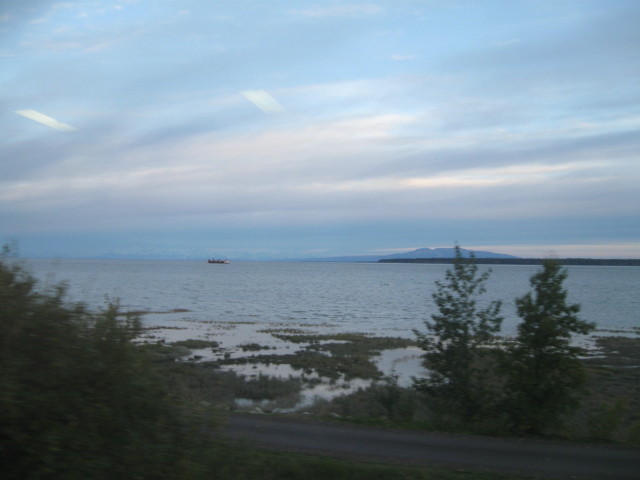
Cook Inlet.
We leave
Anchorage at 8:00 A.M. sharp. We head south thru town then to
meet up with the Turnagain Arm an continue south to Portage. A
route covered several time this week. Only way out of town by
rail if not going north.
MP
114.3 Anchorage
MP 106.2 Turnagain Arm
MP 103.5 Rabbit Creek
- Potter Marsh
MP 100.6 Potter
MP 95.5 Beluga Point
- Beluga Point is named after the Beluga whales that are often
seen in Turnagain Arm near here. Beluga whales are unique in
that they are the only all-white whales. Additionally, due to
the food sources here, the Cook Inlet Beluga whale is a
genetically distinct and geographically isolated stock. We stop
here for several minutes to watch and spot the whales. Several
are spotted but you had to look quick. Mostly just a white speck
all the way across the water. Most people saw at least a couple
Beluga whales.
MP
93.2 Rainbow- We pull into the
siding here at 8:40A.M. to let a freight pass by and pull out at
8:52 A.M.
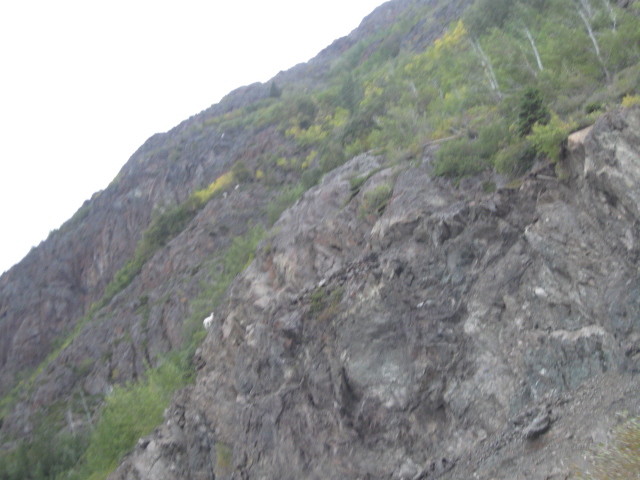
Goat spotted while waiting in siding.
At 9:30 A.M. it was time to head to the diner
for breakfast. Today I decided to eat two meals on the train,
the last day of train travel. For today's breakfast meal, I
chose the Country Starter - A warm biscuit smothered in country
sausage gravy served with fluffy scrambled eggs. Choose from a
side of Alaska reindeer sausage or smoked bacon. It was so tasty
and delicious.
At 10:15 A.M. we pass the
Alaska Wildlife Conservation Center and then arrive at Portage
and then take the Whittier branch to Whittier and our first
photo run by.
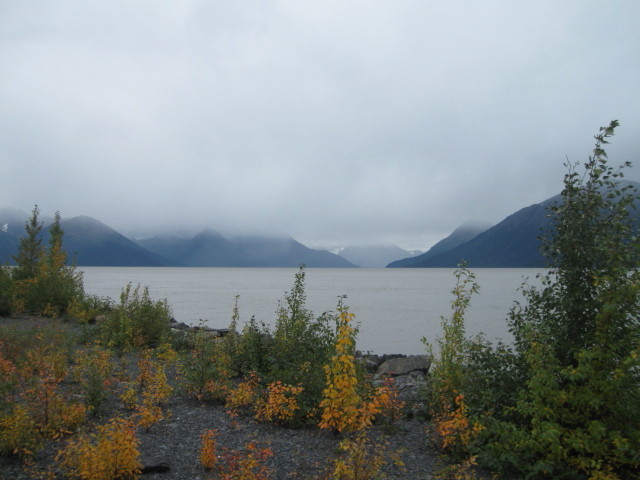
Portage Lake.
Whittier Division
Once known
as the Whittier Cutout or Whittier Branch, this line is
becoming more important to the Alaska Railroad as it is the
major connection to the Lower 48. Barges from Seattle and
Price Rupert dock here, as well as a growing number of cruise
ships.
Plans for
this line began in 1914, but the rough terrain made the route
seem impossible. Railroad manager Otto Ohlson championed this
route because of its ability to provide a shortcut to a deep
water port (a trip to Seward added 52 more miles), the
Whittier Cutoff didn't become a reality until World War II. In
1941, the US Army began construction of the line from Whittier
to Portage. On April 23, 1943, the line was completed. The
route provided many challenges, including a one-mile tunnel
through Begich Peak and 2.5 mile tunnel through Maynard
Mountain. Anton Anderson, an Army engineer, headed up the
line's construction and the main tunnel bears his name.
For the
military, Whittier provided a shorter voyage, reduced exposure
of ships to Japanese submarines, reduced the risk of Japanese
bombings, and avoided the steep railroad grades required on
the Seward line. When completed, the Whittier Cutoff became
Alaska's main supply link for the military. However,
commercial vessels continued to use Seward. In 1960, the
US Army relinquished all control of Whittier and turned the
port and Cutoff over to the Alaska Railroad.
Parts of
the 1985 movie Runaway Train were filmed on this line.
MP F12.4 COHO - This is a
siding and yard just off the mainline to the south. Coho is a
species of a salmon.
We stopped
to get read for our photo runby.
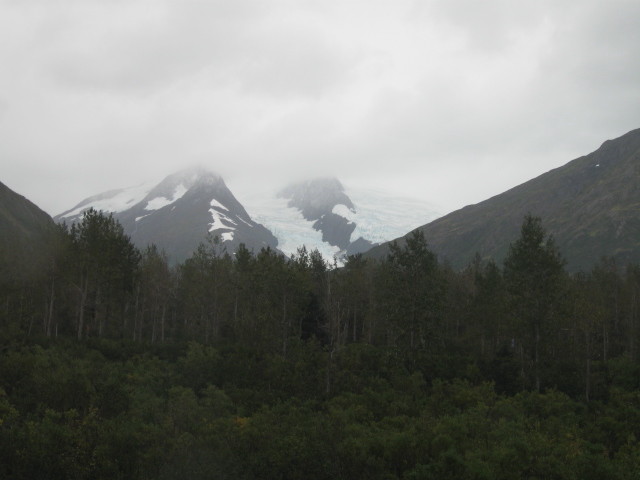
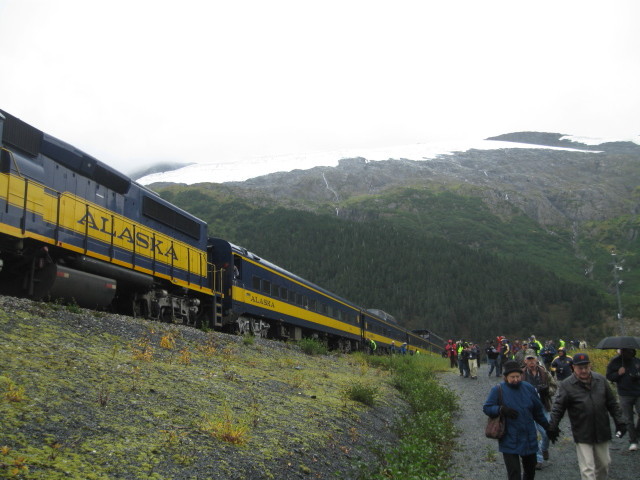
Walking to Photo run by at Placer Creek.
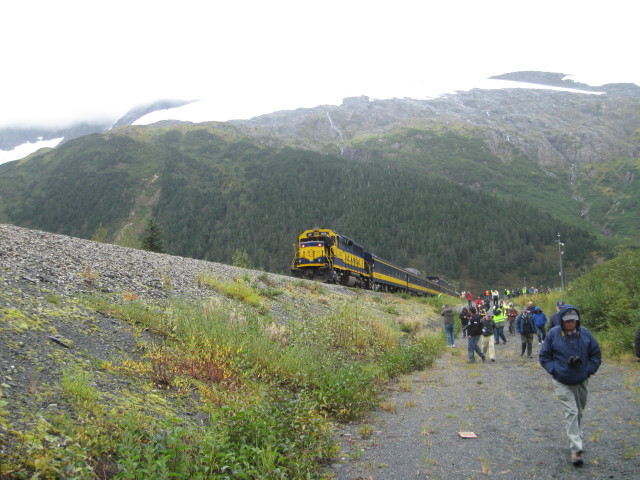
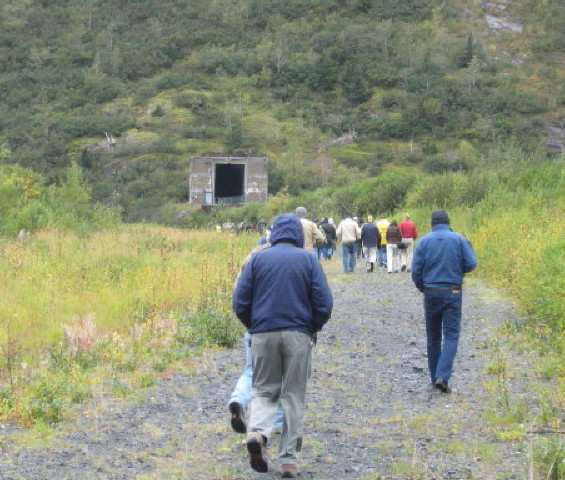
MP F5.8 Portage Tunnel Bear Valley
Portal (Door 3)
At approximately 4905 feet long, this tunnel passes under Begich
Peak.
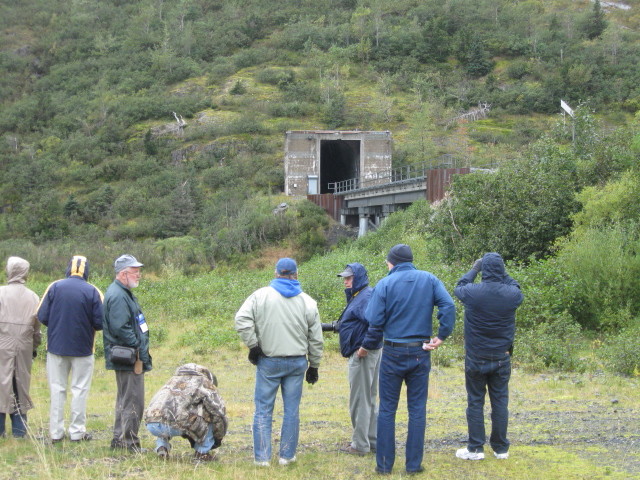
Placer Creek GPS: 60 47 26.3, -148 49
23.5
To
see map, click here Click Back button on your
browser to return to this page.
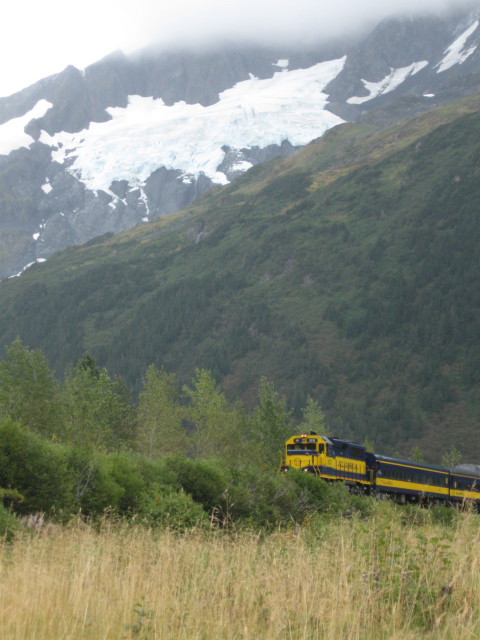
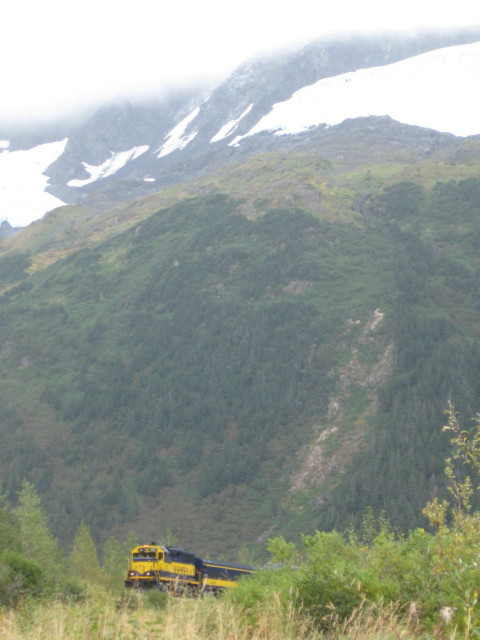
MP F5.3 Bear Valley - Bear
Valley has been described as a desolate bowl full of willows,
rock, and tundra south of Boggs Peak, aptly named for the
wildlife that roam the area. To the south you can view Portage
Glacier and Portage Lake, favorite day trip destinations for
people out of Anchorage.
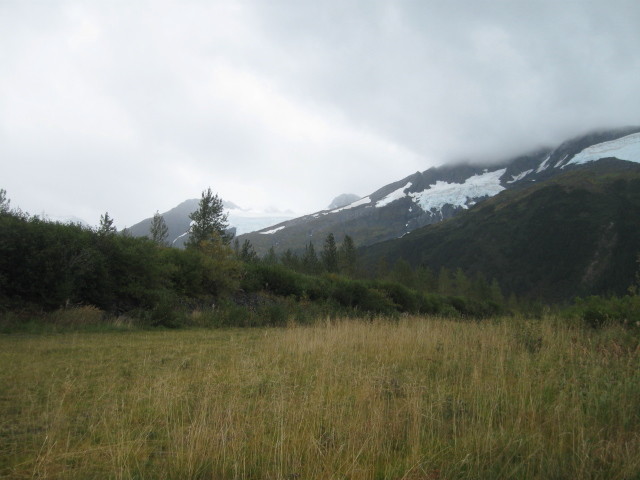
Bear Valley.
MP F5.1 Whittier Tunnel
Bear Valley Portal (Door 2) - Today known as the Anton
Anderson Memorial Tunnel, the tunnel passes under Maynard
Mountain and is the second longest highway tunnel and longest
combined rail and highway tunnel in North America. The rail
line was originally opened on April 23, 1943, linking Whittier
to the Alaska Railroad's main line at Portage. In the
mid-960s, the Alaska Railroad began offering a shuttle service
for automobiles through the tunnel between Whittier and the
former town of Portage. As traffic to Whittier increased, the
shuttle became insufficient, leading in the 1990s to a project
to convert the existing railroad tunnel into a one-lane,
combination highway and railroad tunnel. Construction on this
project began in September 1998, and the combined tunnel was
opened to traffic on June 7, 2000. To coordinate movements
through the tunnel, traffic is scheduled in 20 minute blocks -
twenty minutes each for eastbound highway traffic, westbound
highway traffic, and the Alaska Railroad. By the way, the
tunnel is now a highway toll route with a $12 fare collected
on the eastbound move for a round trip.
We approach the tunnel
and wait for out turn through the tunnel, we notice the alpine
look of the portal. The engineering report on the tunnel
stated the " the portals are built of structural steel and
concrete to safely absorb the shock of any potential avalanche
and are shaped like A-frames to split any snow slide. Each
portal building will house two portal fans (for tunnel
ventilation), emergency vehicles and equipment, power
distribution equipment, furnaces to heat ice-control panels
within the tunnel and remote operations consoles (the main
operations center is in a separate facility). Each portal
building has a train-sized "garage" door that rolls up and
down to let automobiles and trains in and out of the tunnel.
Due to the potential for avalanches, the portal roof on the
Whittier side had been constructed to withstand forces of
1,000 pound per square foot. The roof in made with
14-inch-thick concrete panels. On the Bear Valley side, the
roof is designed to withstand forces of 220 pound per square
foot which is equivalent to about 11 feet of new snow. For
comparison, the building code for Anchorage requires that
building roofs can be constructed to withstand a load of 40
pounds per square foot."
The tunnel was also rebuilt with other
concerns such as ventilation, escape rooms (called "safe
houses" -rooms at 1600 foot intervals for use in case of an
emergency), and pull-outs for broken down vehicles.
By the way, the tunnel is named after Anton
Anderson, an army engineer who in 1941 headed up the
construction of the railroad line from Whittier to Portage.
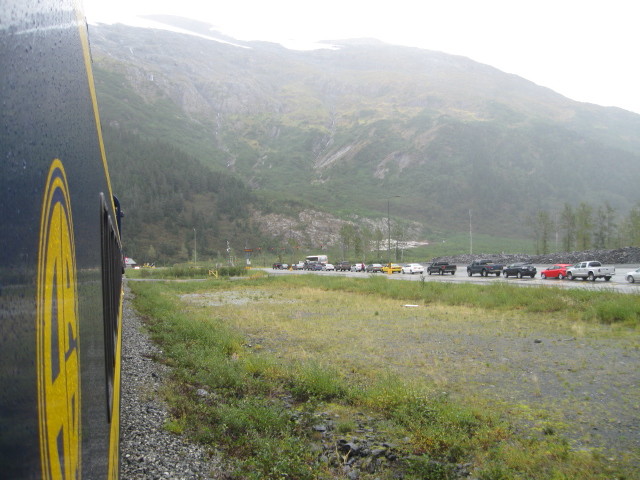
Train and autos queue up for a trip through the tunnel.
After waiting our turn we travel through the tunnel and
arrive in Whittier.
MP F1.2
Whittier Creek - The railroad crosses Whittier Creek on a
9-span wood trestle. Whittier Creek drains the northwest
corner of Whittier Glacier. Whittier Glacier, to the
south, was named for the American poet John Greenleaf
Whittier in 1915, and the creek and community also took
the name. Taking a look around, especially to the south.
Whittier is surrounded by the Chugach National Forest, the
second largest in the United States and a vast wilderness.
The main road into
town crosses the tracks just east of the Whittier Creek
bridge.
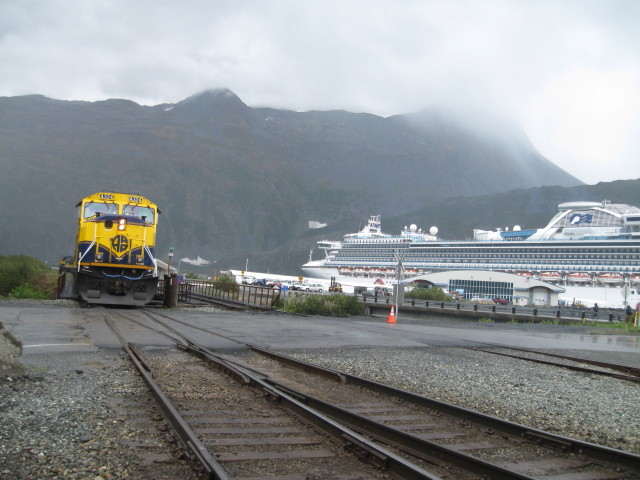
Crossing Whittier Creek and approaching the town's main
road with new cruise ship terminal in right background.
The Alaska Railroad operates dedicated passenger trains
from here to Anchorage and Denali for the cruise ship
lines.
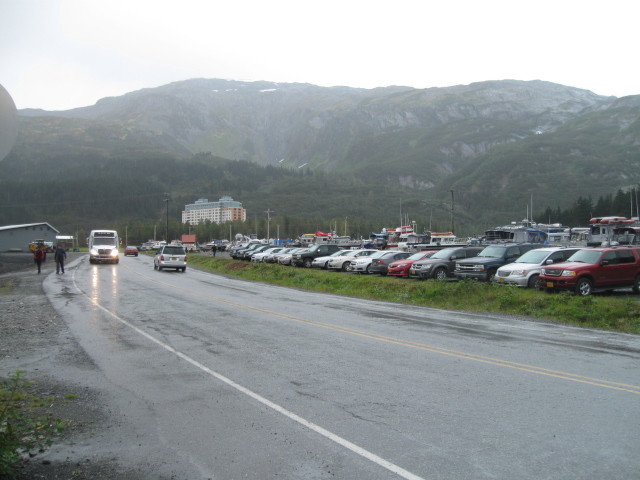
The main road in Whittier.
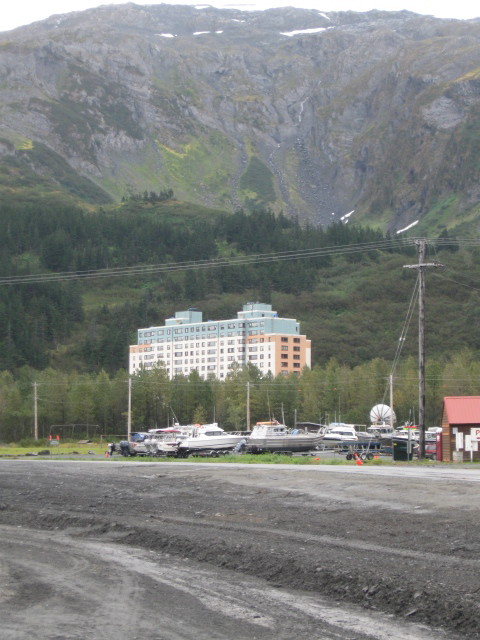
Begich Tower.
Originally called the Hodge Building, and now know as the
Begich Tower, this 14-story structure was at one time the
tallest building in Alaska. Built for family housing, it
was completed in 1956, only four years before Whittier was
inactivated and mothballed by the US Military. The
building initially held 177 apartments and now consists of
condos in which most of Whittier's residents live. The
first floor contains the city offices, grocery, library,
post office and so forth. The interior is '50s
institutional. Its hallways resemble those of a school or
a detention center. One can often find residents shuffling
around in slippers and pajamas. In winters the city gets
about 250 inches of snow and 60mph winds are not uncommon.
The weather is so brutal that children commute from Begich
Towers to school trough a tunnel.
The building was
renamed in 1973 for Congressman Nick Begich, who was
killed in a plane crash the previous year.
MP
F0.8 Whittier Yard - Whittier Yard
contains about a half dozen tracks as well as a small
inter modal facility. The yard was designed to provide
space for cars moving on and off the barges.
To the north of the
yard is the ferry terminal for the Alaska Marine Highway.
Ferry service is available from Whittier to Valdez,
Cordova, Juneau and even Dutch Harbor. With an increase in
cruise ship activity in Whittier, there has also been some
recent development of tourist facilities around the ferry
terminal.
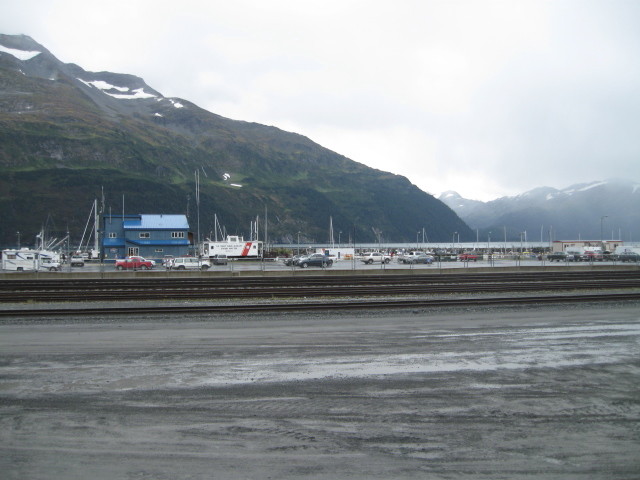
Yard and Prince William Sound.
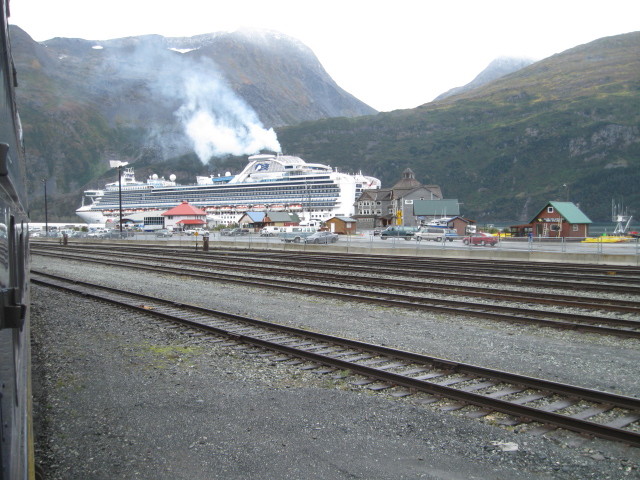
Diamond Princess.
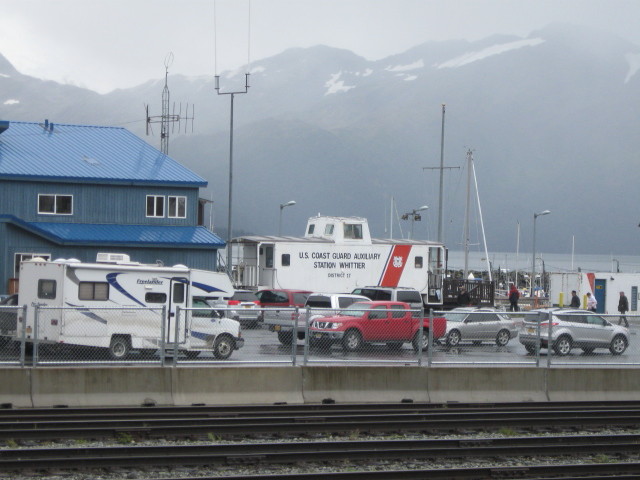
Whittier US Coast Guard Auxiliary - District 17, with their
ex-ARR caboose 1076, which was built by Pacific Car and Foundry
of Renton, WA in 1949.
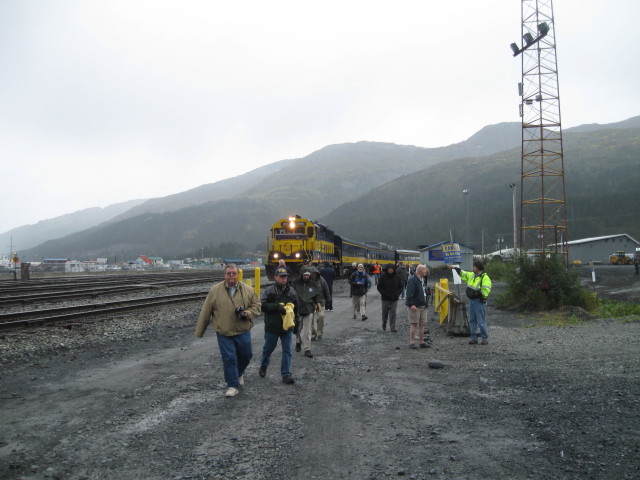
Bart J. directing the photo line to its position.
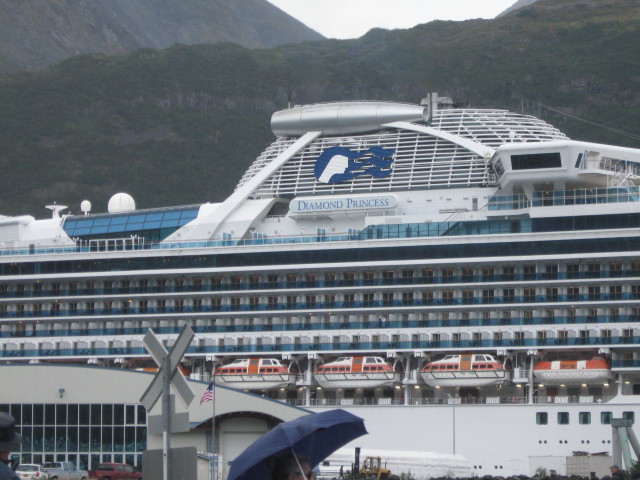
Diamond Princess had arrived from China on a reposition cruise.
MP F0.3 Barge Terminal - The
Alaska Railroad conducts most of its railcar interchange through
the slips at Whittier. The Alaska Railroad operates weekly
service to Seattle using special barges built by Gunderson of
Portland, Oregon. Each barge has 8 tracks of about 400 feet in
length. The barges are designed to handle the railcars on the
deck with containers stacked on frames above. Each round trip
requires three weeks. Besides the ARR service, barge service is
also provided by Canadian National Aqua Train. This service
operates between CN's northwest terminus of Prince Rupert, B.C.,
and Whittier.
The barge slip is like a
bridge, one end is on the land side and the other end rests on
the edge of the barge. There are three sets of tracks on it. The
two towers by the barge slip are the slip towers that have
cables and counterweights on them. Due to the incredibly fast
and high/low tides, the window of time to unload and reload the
barge is rather short, leading to an intricate ballet of trains,
barge, tug and their crews.
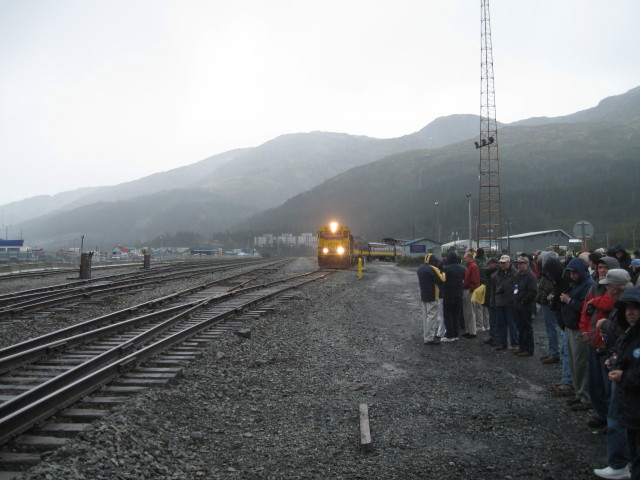
Photo line.
MP F0.0 End of Track - The
Whittier Branch ends/begins along Depot Road near an independent
barge service on Passage Canal, which leads to Prince William
Sound. Whittier is on the northeast shore of the Kenai
Peninsula, at the head of Passage Canal, a location that is
ice-free throughout the year. While a wonderful port area, the
issue has always been access to the interior of Alaska since
this area is surrounded by glacier-covered mountains.
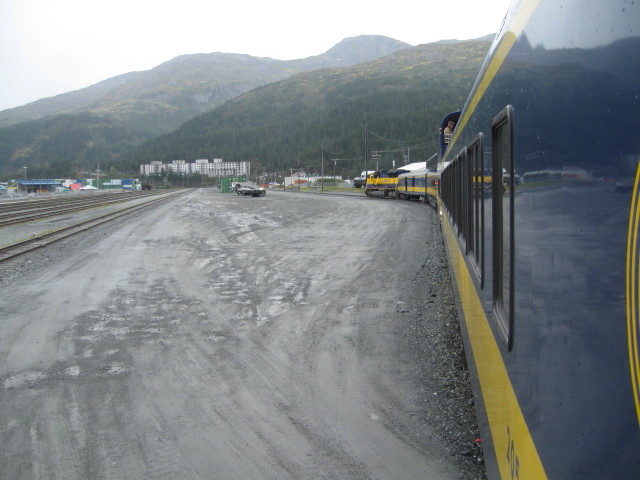
Rail yard with the Buckner Building in the distance.
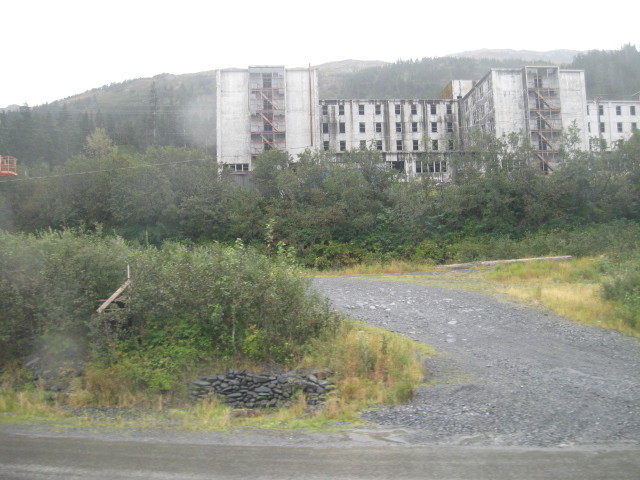
Buckner Building.
On the hillside to the south is a large white
building about six stories tall overlooking the harbor.
This is the Buckner Building, built in 1953 and damaged in the
1964 earthquake and now vacant. (Whittier was severely damaged
by tsunamis triggered by the 1964 Good Friday Earthquake;
thirteen people died due to waves that reached 43 feet.) It once
held 1,000 apartments, a hospital, a bowling alley, theater,
gym, swimming pool, bank, post office, rifle range, and shops
for Army personnel. For many years it was the largest building
in Alaska, and was sometimes called the "city under one roof,"
It still stands due to the difficulty of demolition as the
building contains great amounts of asbestos.
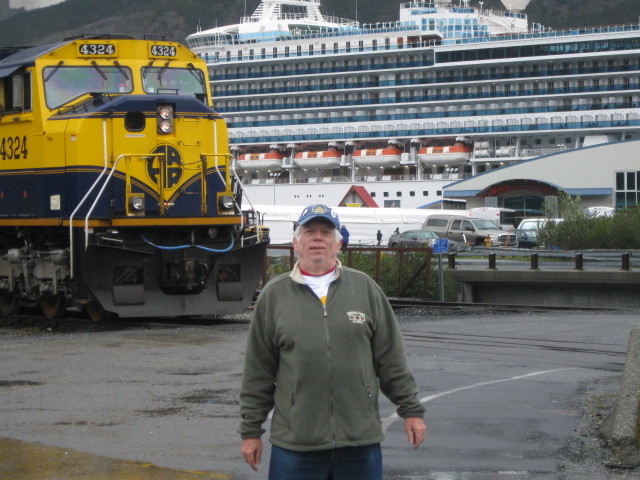
Photo of author by C. Parker.
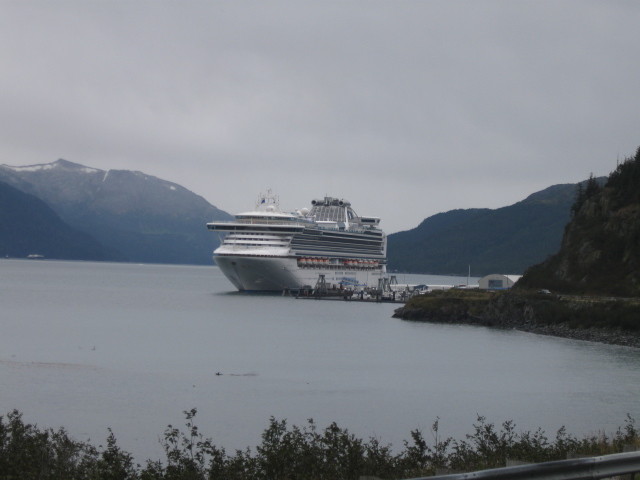
One last look back.
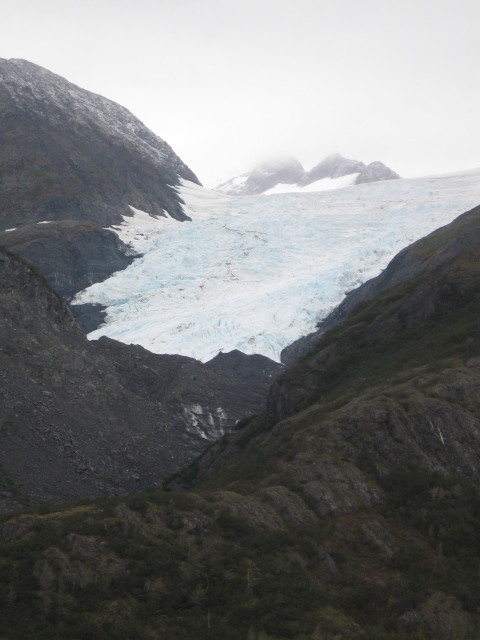
Blue Ice.
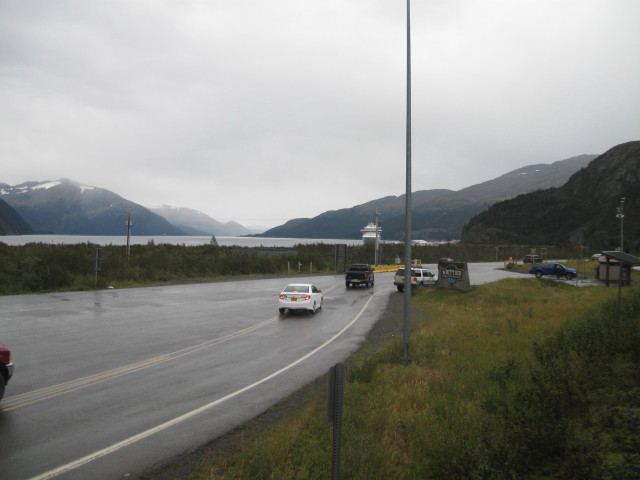
Auto's exiting tunnel in Whittier.
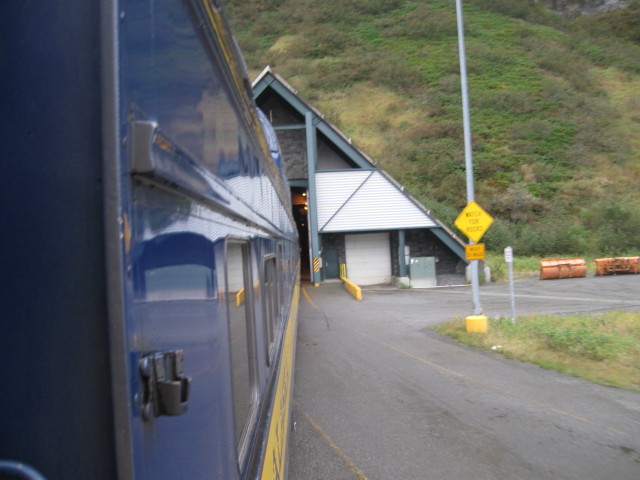
Whittier Portal. (Door 1)
MP F2.6 Whittier
Tunnel Whittier Portal (Door 1) - Traffic through the
tunnel is closely monitored and scheduled to prevent
accidents since the route is single lane throughout.
According to the tunnel's website, "two complex computer
systems are dedicated to help the tunnel operating staff
operate the tunnel in a safe and efficient manner. One of
the most complicated aspects of tunnel construction and
operation is the Tunnel Control System (TCS) and Train
Signal System (TSS). These two computer-based systems make
it possible for cars and trains to safely take turns
traveling through the tunnel.
"The TCS is
responsible for all vehicle movement within the tunnel. An
intelligent traffic system, the TCS tracks each vehicle
and meters through the tunnel. One of its main functions
is to monitor the direction of vehicle movement and,
through its control of the traffic signals and gates,
allow vehicles to travel only in one direction at a time.
The TCS also monitors tunnel operations via live video
covering the length of the tunnel. If a car stops for any
reason, the vehicle detection equipment will alert the
tunnel control operator in the Tunnel Control Center,
direct the video cameras automatically to display that
area of the tunnel, and shut apporopriate gates. The TCS
also conntinually monitors and adust the lighting and
ventilation systems."
"In a simalar
fashion, the TSS is responsible for train movements
through the tunnel. This system conrtols train switches
and signals and ensures that trains only move in one
direction at a time and only when there are no vehicles in
the tunnel."
Because these
systems are linked, the TCS and TSS together ensure that
cars and trains never meet in the tunnel. When the tunnel
is in the railroad mode, the TSS controls the trains and
locks out the operation of the TCS syustem. All highway
gates are closed and the highway signals are set to red.
When the tunnel ia in highway mode, the TCS locks out the
TSS until highway vechicles are cleared arom the tunnel.
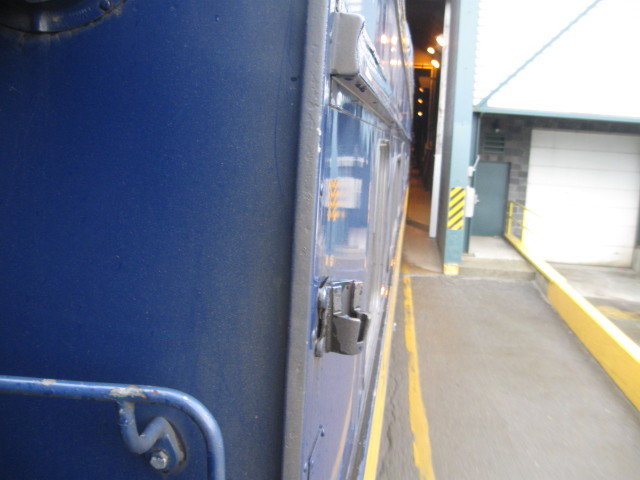
Entering the Whittier Portal (Door 1).
It was nearly 1:00P.M. when we enter the tunnel at
Door 1 and make our way to Portage and the Turnagain
Arm. After meeting the main we then head south towards
Seward. Meanwhile I make my way to the dining car. For
my last train meal on this trip to Alaska I choose
Healy Miners Lucnh. A burger fit for a hungry miner.
Choose an Angus beef patty or Garden burger served
with crisp green leaf lettuce, tomato and onion on a
bun with pickle wedge. Choose Alaska Chip Company
Kettle Chips or a side of fresh fruit. Add cheddar,
Swiss, blue cheese crumbles, or bacon. It was a good
hanburger that hit the spot.
MP 55.8 Spencer -
Spencer is a 3054-foot siding to the west, named after
railroad employee who seemed to have everything in the
area named after him. This was a flagstop by 1913. The
Tincan Peak immediately to the west. Tican is one of
the most popular areas for backcountry skiing due to
its acess from the Seward Highway. Spencer is one of
six locations between Portage and Moose Pass getting
new passenger shelters, toilets and interpretive
displays.
We stop here for
our next photo run by. For this one I decide to stay
on the train and watch from this side of the window.
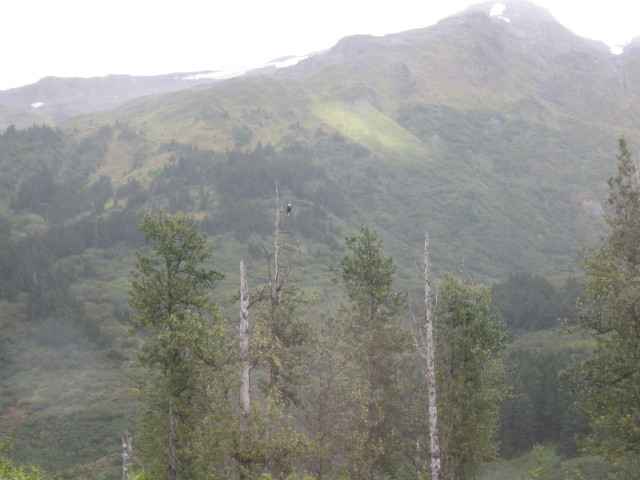
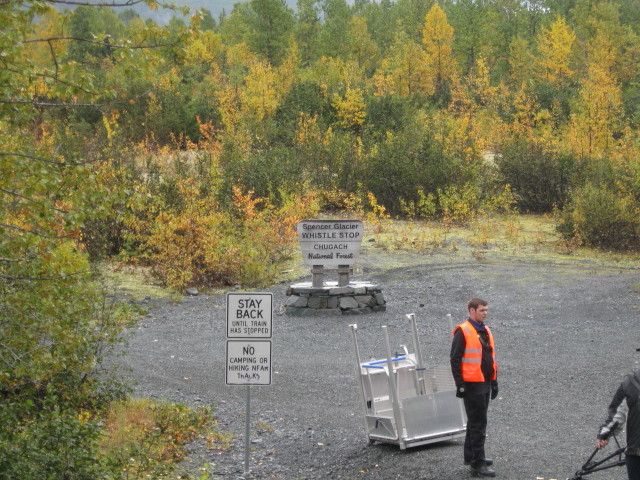
Where the photographers were drop off.
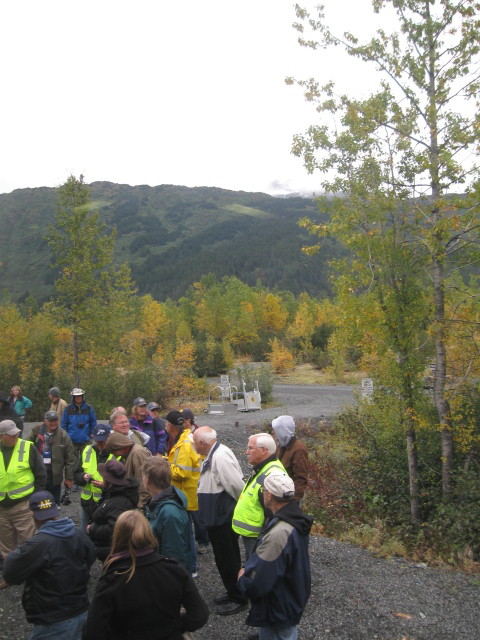
Waiting to re-board after taking photos.
After our stop here we
head north to Anchorage along the Turnagain Arm. At Beluga Point
we stop and spend some time watching the white wales.
At 5:35
P.M. we arrive at the Anchorage. Stepping outside in front of
the station, I take a picture of Alaska Railroad # 1.
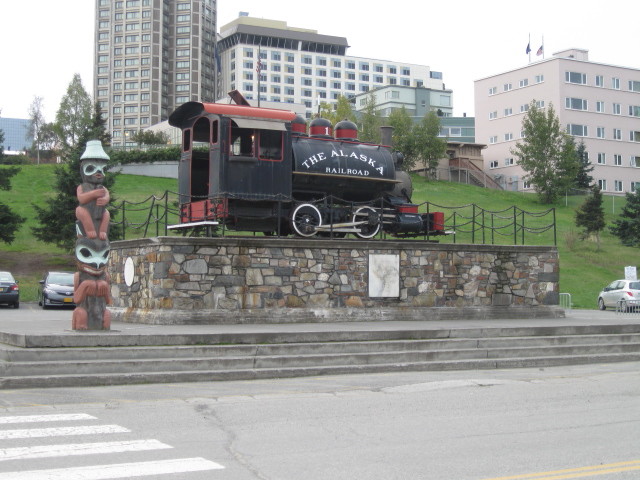
# 1 in front of Anchorage Station with the Anchorage Hilton in
background left of center.
Across from the station is Alaska
Railroad # 1, an 0-4-0ST built by Davenport in October,
1907. This locomotive was originally built as narrow gauge
#802 for work on the Panama Canal. In 1917 a large amount of
equipment was transferred from the canal project to the
Alaska Railroad Commission, including this engine as # 6. It
was converted to standard gauge in 1930 and renumbered to #
1.
Back at the motel, our
little group decided to go to dinner together as this was
the last night here for us. Tomorrow we would leaving for
home with everyone taking different flights and at different
times. So our little group of Chris G., Chris P., Elizabeth
A. and I head to the Sizzlin Cafe for dinner. We each had a
good meal and talked about all our adventures on this 2013
NRHS convention. After breaking bread, we then all head back
to the motel.
I saw an article in
the local paper that peaked my interest. The "Anchorage
Daily News," 9/20/2013 article: Performance art - Light
Brigade. Anchorage aerialists, dancers, musicians and others
join as "The Light Brigade" in a site-specific multimedia
art performance that will include wild lighting and film
projections outside the Anchorage Museum, 625 C St. The
event takes place as the night falls on summer for the last
time in 2013, at 9:30 P.M. Saturday. The show is part of the
museum's Northern Initiative and it's free.
I thought this would be a
great ending to this visit to watch this performance. It was
happening in a few hours, a short ten minute walk from the motel
and this was a chance to get out and mix with the locals. I went
by myself as no one else was interested in going. Tonight was
also "Pirate Night." The locals were dressed in pirate costumes,
going on a bar circuit and stopping in each for drink and then
moving on to the next on the circuit. So while walking to the
museum, I saw some wild and interesting costumes with everyone
in a festive mood.
Upon arriving at the
museum, the area in front of the building was filling with
spectators. When the performance started the crowd had filled
the lawn with hardly any place left to stand. I was impressed
with the turnout to watch this show. There were a lot of people
here at 9:30 P.M. with some overflow into the sidewalk.
I really enjoyed the show and the talented performers were
excellent. The show seem to me like a marriage between rock
climbing and ballet. Aerialists are suspended from the roof of
the Anchorage Museum and perform on the front facade of the
building. So glad I decided to attend this once in a life time
experience.
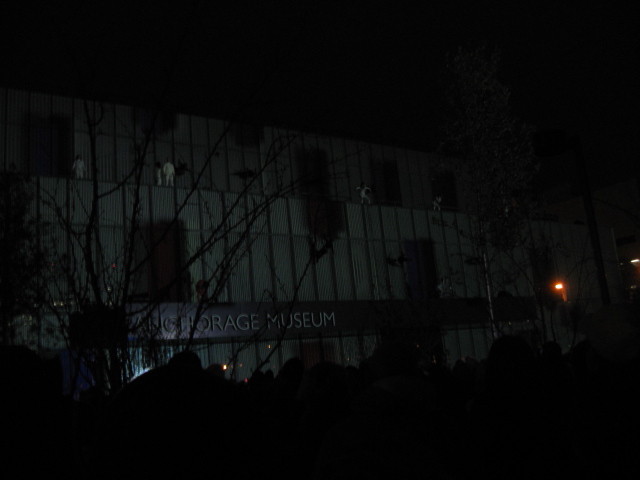
Light Brigade - a group of local performance artists.
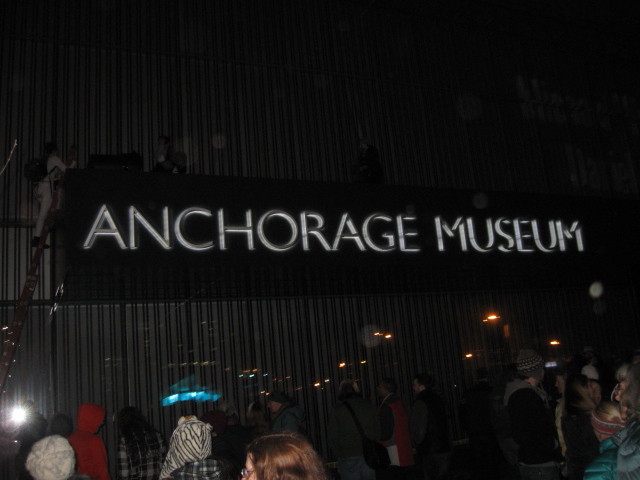
After
the show the crowd and I move to the city streets. I head
north to 5th Ave and then walk back to the motel.
Tomorrow is the last
day here in Alaska and we are going to visit Wasilla.
FYI:
Anchorage Museum
Thanks for reading
